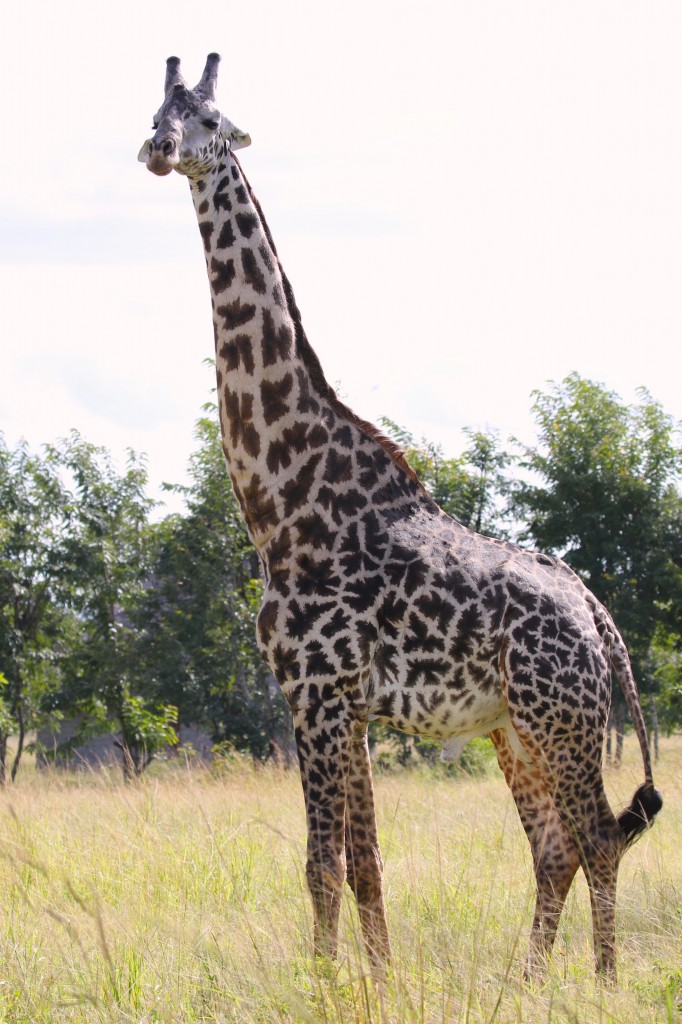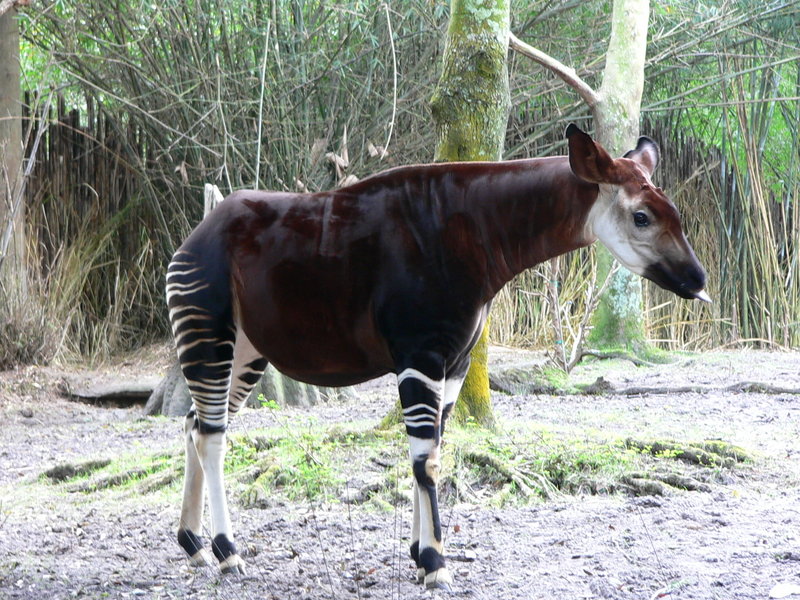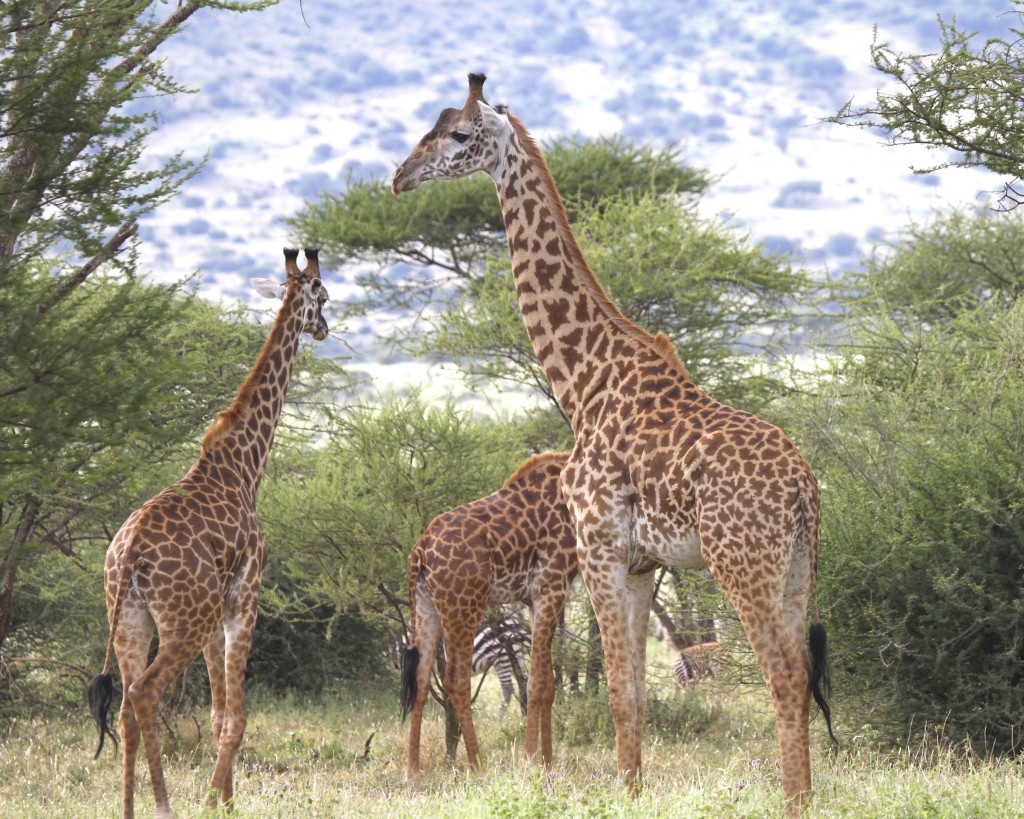For the first time ever, scientists have sequenced the genome of the world’s tallest land species, the giraffe. Surprisingly, this majestic creature required only a small handful of mutations to attain its remarkable physical stature and physiology — but these mutations packed an evolutionary punch.
Fighting giraffes in Ithala Game Reserve, northern KwaZulu-Natal, South Africa. (Image: Luca Galuzzi)
With their long necks and elegant strides, giraffes have captivated humanity for thousands of years. But there’s more to these animals than their height, which can reach upwards of 6m.

Adult male Masai giraffe in the Mikumi National Park, Tanzania. (Image: Doug Cavener)
Giraffes are surprisingly swift runners, capable of sprinting 60km/h. They also need to pump blood nearly 2m straight up in order to supply their brains with an ample oxygen supply. To that end, giraffes have evolved a rather large left ventricle, and a blood pressure that’s about twice as high as other mammals. They’re also capable of digesting acacia leaves and seedpods — highly nutritious foods that are poisonous to most other animals.
The reasons for the giraffe’s long legs and neck are fairly obvious, and have been discussed since before the time of Darwin. Biologist Jean-Baptiste Lamarck famously argued that giraffe necks needed to get longer so they could reach food way up high (that is, “Lamarckian evolution”). He was almost correct. As Darwin later pointed out, their necks were the result of selectional processes; only those animals with necks long enough to reach the tallest branches thrived and survived.
This much we knew, but scientists weren’t sure about the exact biology involved, and how giraffes, from a genetic perspective, evolved their panoply of characteristics. Its closest living relative, the okapi, looks more like a zebra than its lanky cousin, so there aren’t other “intermediate” species to go by.
In an effort to learn more about the genetic constitution of the giraffe — and to paint a clearer picture of its evolutionary history — scientists from Penn State University sequenced the entire giraffe genome (along with the okapi genome), making them the first to do so. The results, which now appear in Nature Communications, are offering intriguing insights into how the giraffe’s unique body shape evolved.
To isolate the genes responsible for the giraffe’s unique characteristics, a research team led by Douglas Cavener and Morris Agaba compared the gene-coding sequences of the giraffe and the okapi to more than 40 other animals, including cows, sheep, goats, camels and humans. Despite the giraffe’s unique appearance and physiology, the researchers came up with just 70 genes that were responsible for some of the giraffe’s most distinctive adaptations.

An Okapi (Image: Raul654)
As noted, the giraffe and okapi feature genetic sequences that are quite similar. The two species are very closely related, having only diverged from a common ancestor about 11 to 12 million years ago. Aside from their heads and hooves, these animals look almost nothing alike, but genetically, there’s very little to distinguish the two species. By studying the okapi genome, the researchers were able to use it as a kind of genetic filter to pinpoint the genes that make a giraffe a giraffe.
The researchers sequenced the whole genomes of two female Masai giraffes from the Masai Mara reserve in Kenya and the Nashville Zoo in the United States, and one male okapi from the White Oak Holdings in the United States. Among the 70 distinctive genetic mutations discovered, over half of them coded for proteins that regulate development of the giraffe’s skeletal, cardiovascular and nervous system. Interestingly, several of these genes showed signs of multiple adaptations, meaning they confer more than one benefit, or characteristic. For example, some genes control both cardiovascular and skeletal development. The researchers speculate that the giraffe’s stature and “turbocharged” cardiovascular system evolved together through changes in a small number of genes.

An adult male Masai giraffe in Ndarakwai – West Kilimanjaro, Tanzania. (Image: Doug Cavener)
Cavener and Agaba discovered genetic clues that explain how the giraffe evolved such a long neck and legs which, despite their length, feature the same number of bones as the neck and legs of humans and other mammals.
“To achieve their extraordinary length, giraffe cervical vertebrae and leg bones have evolved to be greatly extended,” said Cavener in a release. “At least two genes are required — one gene to specify the region of the skeleton to grow more and another gene to stimulate increased growth.”
One of these two genes is called FGFRL1, and it plays an important role in the early development of an embryo. It also contributes to the rapid bone-growth phase after a giraffe is born. In fact, this gene has been associated with severe skeletal and cardiovascular defects in both humans and mice when it fails to express properly. This gene, in conjunction with four homeobox genes — which are involved in the development of body structures — provides two of the required elements for the evolution of the giraffe’s long neck and legs.
“What we think has occurred then, is the giraffe evolved a long neck, which occurred over roughly a 15 to 20 million year period, and as its neck extended out, its cardiovascular system was also changing in tandem — and that some of the same genes were actually controlling both processes in concert,” noted Cavner in an accompanying video.
Finally, the researchers also discovered a group of genes that regulates metabolism and growth. These are genes that are likely responsible for the giraffe’s ability to metabolise acacia leaves and seedpods, which many other mammals find toxic.
Moving forward, the researchers would like to fuse the FGFRL1 gene into the mice genome to see how it affects their growth, particularly in its spine and legs. This could eventually lead to treatments in humans who are suffering from skeletal abnormalities and other physiological ailments. The sequencing of the giraffe genome, it would appear, is a scientific effort that’s extending beyond the scope of just zoology and evolutionary biology.
